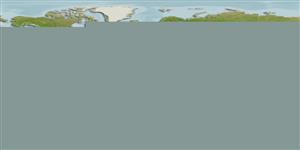Elasmobranchii (haaien en roggen) (sharks and rays) >
Squaliformes (Sleeper and dogfish sharks) >
Squalidae (Dogfish sharks)
Etymology: Squalus: Genus name from Latin 'squalus' meaning shark (Ref. 6885, 27436); albifrons: Name from Latin 'albi' for white and 'frons' for brow, referring to the white upper ocular margin in most specimens where denticles have been shed..
More on authors: Last, White & Stevens.
Environment: milieu / climate zone / depth range / distribution range
Ecologie
marien; diepte 131 - 450 m (Ref. 58440). Tropical
Western Pacific: eastern Australia.
Grootte / Gewicht / Leeftijd
Maturity: Lm ? range ? - ? cm
Max length : 74.0 cm TL mannelijk / geslacht onbekend; (Ref. 58440); 86.0 cm TL (female)
Korte beschrijving
Morfologie | Morfometrie
This large species belonging to the 'highfin megalops group' has the following set of characters: abdomen depth 10.4-12.6% TL; pre-vent length 46.9-48.1% TL, 2.0-2.2 times dorsal caudal margin; pre-second dorsal length 3.7-4.3 times the pectoral-fin anterior margin, 2.5-2.8 times dorsal caudal margin; head width 1.0-1.4 times abdomen width; preoral length 2.9-3.1 times horizontal prenarial length, 8.4-9.1% TL; head length 4.3-4.9 times its eye length; mouth width 3.3-4.1 times length of upper labial furrow; interorbital width 1.5-1.7 times the horizontal preorbital length; fifth gill slit height 2.1-2.5% TL; strongly bifurcated anterior nasal flap; first dorsal fin upright, upper posterior margin directed posteroventrally, greatest concavity about midway between free rear tip and fin apex; posterior margin of second dorsal fin deeply concave; second dorsal-fin spine with a broad base; pectoral fin of adult not falcate, anterior margin long, 14.2-15.8% TL; dorsal surface dark, sharply demarcated from paler ventral surface on side of head; dorsal fins are dark with obvious darker tips; first dorsal-fin spine distinctly paler than the base of soft portion of dorsal fin; caudal fin with broad white posterior margin, caudal bar absent; flank denticles weakly tricuspid; monospondylous centra 44-46, precaudal centra 89-93, total centra 116-122 (Ref. 58440).
Levenscyclus en paargedrag
Maturiteit | Voortplanting | Paaien | Eieren | Fecunditeit | Larven
Distinct pairing with embrace (Ref. 205).
Last, P.R., W.T. White and J.D. Stevens, 2007. New species of Squalus of the 'highfin megalops group' from the Australasian region. p. 39-53. In P.R. Last, W.T. White and J.J. Pogonoski Descriptions of new dogfishes of the genus Squalus (Squaloidea:Squalidae). CSIRO Marine and Atmospheric Research Paper No. 014. 130 p. (Ref. 58440)
Status op de Rode Lijst van het IUCN (Ref. 130435)
Gevaar voor de mens
Harmless
Gebruik door de mens
Meer informatie
Leeftijd/GrootteGroeiLengte-gewichtLengte-lengteLengtefrequentiesMorfometrieMorfologieLarvenLarvale populatiedynamiekRekruteringAbundantieBRUVS
ReferentiesAquacultuurAquacultuurprofielKweeklijnenGeneticaElectrophoresesErfelijkheidZiektesVerwerkingNutrientsMassaconversie
Tools
Speciale rapporten
Download XML
Internetbronnen
Estimates based on models
Preferred temperature (Ref.
123201): 13 - 21.4, mean 19 °C (based on 34 cells).
Fylogenetische diversiteitsindex (Ref.
82804): PD
50 = 0.5000 [Uniqueness, from 0.5 = low to 2.0 = high].
Bayesian length-weight: a=0.00339 (0.00162 - 0.00707), b=3.10 (2.93 - 3.27), in cm total length, based on LWR estimates for this Genus-body shape (Ref.
93245).
Trofisch niveau (Ref.
69278): 4.3 ±0.4 se; based on size and trophs of closest relatives
Weerstandsvermogen (Ref.
120179): Zeer laag, minimale populatieverdubbelingstijd meer dan 14 jaar (Preliminary K or Fecundity.).
Fishing Vulnerability (Ref.
59153): Moderate to high vulnerability (54 of 100).
